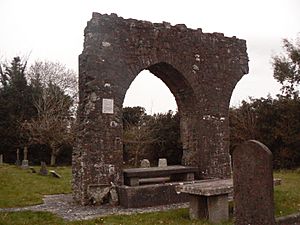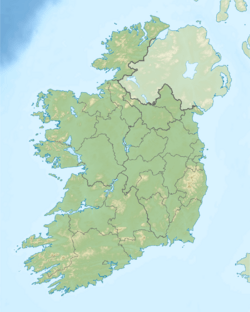St. Seachnall's Church facts for kids
Quick facts for kids St. Seachnall's Church |
|
|---|---|
|
Domnach Sechnaill
|
|
 |
|
| 53°30′51″N 6°32′21″W / 53.514242°N 6.539295°W | |
| Location | Seachnall Place, Dunshaughlin, County Meath |
| Country | Ireland |
| Denomination | Church of Ireland |
| Previous denomination | Pre-Reformation Catholic |
| History | |
| Dedication | Secundinus |
| Architecture | |
| Style | Celtic Christianity |
| Years built | 10th/11th century |
| Closed | 18th century |
| Specifications | |
| Materials | limestone |
| Administration | |
| Diocese | Meath |
St. Seachnall's Church is a very old church from the Middle Ages. It is located in County Meath, Ireland, and is considered a National Monument. This means it's a special historical site protected by the country.
Contents
Where is St. Seachnall's Church?
St. Seachnall's Church is right in the middle of Dunshaughlin. It's just a little bit east of the main R147 road. If you look at the road, it actually curves around the church. This suggests that the church area has been important for a very long time, shaping the town's layout.
The History of St. Seachnall's Church
Who was Saint Secundinus?
The church is named after Secundinus, also known as Seachnall. He lived a very long time ago, passing away in 447 AD. Secundinus was the son of a man named Restitutus and a woman named Lubaid. People traditionally say that Lubaid was the sister of Saint Patrick, a very famous saint in Ireland. Secundinus is believed to have started a church on this very spot between the years 439 and 447 AD. The town's name, Dunshaughlin, actually comes from Domhnach Seachnall, which means "the church of Seachnall." The name Máel Sechnaill, meaning "servant of Seachnall," was also common among the ancient Kings of Tara.
Ancient Legends and Church Leaders
There's an old story in a book called An Leabhar Breac. It says that a special church song, the 7th-century Eucharistic hymn Sancti venite, was first sung by angels at Dunshaughlin. This happened after Secundinus and his uncle, Saint Patrick, became friends again.
Leaders of the church, called abbots, are mentioned in records from the 9th century. The first one recorded was Ruamnus, who died in 801 AD. These leaders continued until Scannal mac Fergil, who was sadly murdered in 886 AD. Later, in the 10th and 11th centuries, records also mention erenachs and coarbs of Dunshaughlin. These were like lay guardians, or local leaders, who looked after the church and its lands.
Attacks and Changes Over Time
The monastery at Dunshaughlin faced tough times. It was burned down during raids in 1026, 1142, and 1143 AD. It was also attacked and robbed by a group called the Uí Briúin in 1152.
Dunshaughlin was likely an important church for the Síl nÁedo Sláine kings, who ruled in the 6th to 8th centuries.
After the Norman invasion of Ireland, Dunshaughlin became a special area called a seigniorial manor under Hugh de Lacy, Lord of Meath. There's an old earthwork about 700 meters south of the church that might have been a motte, a type of small castle mound, built by him. After this, the church became a local parish church.
Later History of the Church Building
A church in "Denclynschael" was listed in church tax records from 1302–06. Later, in 1622, James Ussher, who was an Archbishop for the Church of Ireland, said that the church and its main area (chancel) were in ruins. However, in 1749, a writer named Isaac Butler described the church and its tower as being in good condition, though the chancel was still ruined.
The church building you see today, which belongs to the Church of Ireland, was built in 1813. It was constructed just north of the older church's remains.
What Remains of the Old Church?
The old parish church has some interesting parts left. You can see one pointed arch and two piers, which are like strong columns. These suggest that the church's main area, called the nave, used to have aisles on the sides.
There's also an eight-sided limestone font, which is a basin used for baptisms. This font has been moved to the newer church. It has cool carvings on it.
Another interesting feature is a crucifixion scene carved above the doorway. This carving is done in a style called false relief, where the image seems to stand out from the background.


